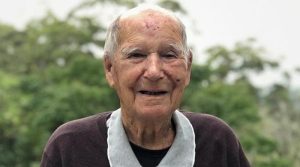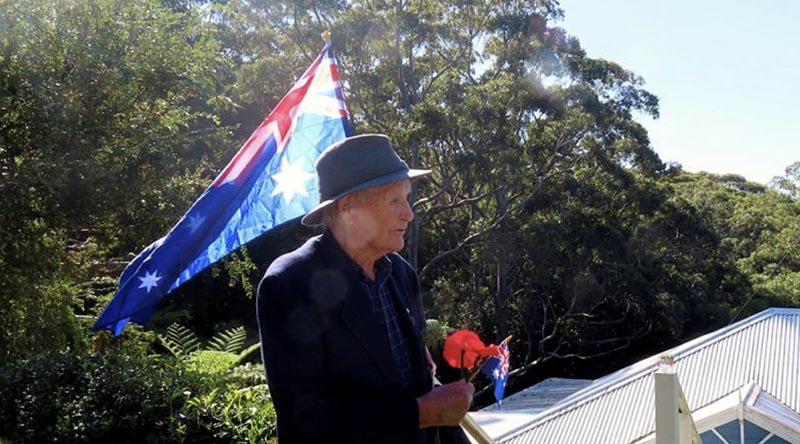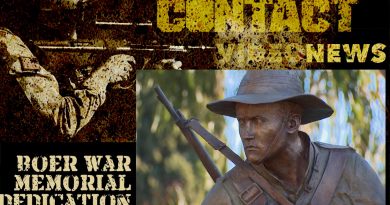Honour lines the streets

A World War 2 veteran has lived a story worth telling and continues to make his mark.
For the last three years, John Edwin ‘Jack’ Bartlett has held his own Anzac Day parade on Chapman Crescent at Avoca Beach, NSW.
Mr Bartlett hadn’t missed a march since the end of WW2, so when COVID-19 cancelled the ceremony in 2020 the spritely veteran arranged his own, down the street where he lives with his daughter.
A family friend, Daune Coogan, spread word of Mr Bartlett’s march around, encouraging people to cheer him on, and said the community response was overwhelming.
“At about five to 10 there was nobody, but at five past 10 when we walked up onto the road there must have been a hundred people,” Ms Coogan said.
At last year’s march, about 300 people supported Mr Bartlett and the fire brigade blocked the street to stop traffic.
Mr Bartlett was pleased that people were interested to hear his story and of those before him.
“It’s a wonderful feeling to think of what we did when we were kids of 18, and see all the people, especially the children, cheering me on,” he said.
“I was so pleased to see the children, who didn’t know what war was about, but they came and watched the old veterans marching up the street.”
Now 99, Mr Bartlett is still marching – this year, handing out flags to children, who he hopes will remember to honour veterans on Anzac Day.
All it took was clothes, boots and food
Born in Ganmain on November 29, 1923, Mr Bartlett moved to Deniliquin after hay trucks came to town and put his father out of work in 1934.
He left school at 14 to work as a boundary rider and sheep shearer, but when he turned 18, Mr Bartlett said he couldn’t get off to the war quick enough.
“You got a free pair of clothes, a free pair of boots and something solid to eat. Wonderful times,” he said.
But Mr Bartlett’s hopes to be a sailor took a detour, when the recruiter said he was too small and light to join.
“They said go around the corner and join the Army. They’ll feed you and put some weight on you, and that they did,” Mr Bartlett said.
He enlisted in the Army in January 1942, and spent time in 46 Battalion before transferring to Navy in September 1942.
After training at HMAS Cerberus he was posted to HMAS Manoora, an armed merchant vessel converted to an infantry landing ship.
He was involved in nine major landings. The first was the Island of Sio, then Humboldt Bay.
Here, General Douglas Macarthur, commander of the American campaign in the Philippines, came on board and Mr Bartlett was invited by the ship’s captain to meet the general and shake his hand.
‘You got a free pair of clothes, a free pair of boots and something solid to eat. Wonderful times.’
Their next landing was at Morotai, where, after the island was captured, they helped build an Air Force base.
They next lurched up into the Philippines, capturing Leyte Gulf, Lingayan Gulf, Corregidor Island and Manila Bay.
“When we were fighting in the Philippines, those were tough days. Don’t let anybody tell you different. You might spend all day at the gun,” he said.
“You never had time to go down and eat, so the cooks would make a big pot of mulligatawny stew and bring it up to each gun in a big dish. If there were eight sailors you got eight spoons. Half would eat and half would watch out for planes.”
The legend of Boom Boom Jack

He returned to Australia after the war, and was on the Manoora until March 1946.
In Easter 1947 he sailed to New Guinea. But after arriving, was taken off the ship and put on a plane specially sent for him, to Port Moresby.
Two large sea mines had floated to the beach in front of the RSL and would disrupt an event hosted by COL Murray, administrator of Australian territories in New Guinea.
Mr Bartlett disarmed the mines, then was taken to the Air Force base at Konedobu where he stayed disarming mines that washed up every two or three days.
One day, after returning from a job, Mr Bartlett was met by a soldier with a rifle and bayonet who was there to arrest him for desertion.
When Mr Bartlett left Australia at Easter, the embarkation clerk mistakenly put his name against HMAS Hobart.
The soldier couldn’t believe Mr Bartlett was a sailor because he didn’t look like one.
“I had Army boots, no socks, an Army hat, and from an airman who was heading back to Australia, his shirt and shorts,” he said.
“I said ‘if you spent all day swimming around in dirty water you wouldn’t wear your white suit out either’.”
The ordeal was sorted out and Mr Bartlett stayed to disarm bombs and mines around New Guinea, New Britain, New Ireland and Solomon Islands.
He became known to locals as Boom Boom Jack because he was always setting off explosions to dispose of mines.
His reputation was so well known, when a mine floated underneath a hospital on Port Moresby harbour, a patient who said he could not get out of bed was able to quickly move when he found out Mr Bartlett was sorting out the mine.
Going out with a bang
After about 18 months, Mr Bartlett returned to Sydney and posted to HMAS Rushcutter to conduct an anti-submarine course.
Mr Bartlett was drafted to a frigate and spent 12 months in Japan, returning to Australia as a petty officer and posted to HMAS Australia.
His job on board Australia was to look after about 60 National Servicemen and keep the ship clean.
He was so successful that a visiting officer, after establishing that there were no torpedoes on board, promptly sent Mr Bartlett back to Rushcutter with a promotion, because “he had never seen a ship so clean and tidy and so useless to the Navy”.
Mr Bartlett spent two more years at Rushcutter, occasionally disarming mines near Cairns that would break free from the anti-submarine minefield, one of which is located at the Port Douglas Anzac Memorial to this day.
His last year in service was spent teaching ships captains how to steer vessels using the ASDIC set – later known as sonar – in anti-submarine warfare.
“I used to take these senior captains for one month, just the two of us, and teach them how to work the set, locate the submarine and fire the new weapons,” he said.
When Mr Bartlett discharged in September 1954, he was a chief petty officer, torpedo and anti-submarine instructor and the only remaining wartime sailor specially trained in bomb and mine clearance.
The next 30 years were spent in the transport industry as a radio operator, and at 60, Mr Bartlett retired on the wartime sailor’s pension.
He is the only surviving member of Manoora and the Landing Ship Association, which also included HMA Ships Kanimbla and Westralia.
Remembering the fallen
Mr Bartlett will celebrate his 100th birthday in November and said he is well looked after and feeling good.
“I’m physically fit as a fiddle. A bit of a wonky knee, but I can get around with a walking stick,” he said.
His memory is sharp and anyone you talk to will tell of his razor wit.
‘Instead of a grave, on a board, beneath a flag, 4-inch shell between the legs to take them to the deep. They’re the ones I really feel sorry for.’
Mr Bartlett wasn’t the only member of his family to serve during the war. His sister Ada was a sergeant in the Signal Corps.
His brother Jim tried to join in Deniliquin but was turned away because of rheumatic fever. He signed up in Bendigo under a different name, but unfortunately, the clerk from Deniliquin had also travelled there and “turfed him out backwards”.
Jim went on to join the Civil Construction Corps with their father, spending four years constructing roads around Australia for the Army.
One of Mr Bartlett’s fondest memories is attending NSW State Parliament in Sydney to receive the Philippines Liberation Medal, for his part in the campaign.
But he never forgets the sailors who were killed in action and buried at sea.
“Instead of a grave, on a board, beneath a flag, 4-inch shell between the legs to take them to the deep. They’re the ones I really feel sorry for. Their friends and family can’t visit their war graves, all they’ve got is a latitude and longitude,” Mr Bartlett said.
.
.

.
.





